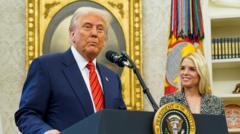In a historic election, Greenlanders are weighing their future ties with Denmark against a backdrop of rising calls for independence, influenced by increasing U.S. attention.
Greenland's Pivotal Election: Independence on the Horizon Amid U.S. Interest

Greenland's Pivotal Election: Independence on the Horizon Amid U.S. Interest
As Greenland heads to the polls, the U.S. interest in the territory shines a new light on the quest for independence.
Residents of Greenland cast their votes on Tuesday in a critical election year, one that has gained unprecedented attention largely due to U.S. President Donald Trump's continued interest in acquiring the territory. While the elections typically drew little interest from outside, this time it highlights the long-running discussions around Greenland's future relationship with Denmark.
There’s a growing momentum for independence, with five of the six political parties on the ballot supporting the idea, albeit with differing timelines. "There's never been a spotlight like this on Greenland before," states Nauja Bianco, a policy expert focused on Arctic governance. Historically under Danish control for nearly three centuries, Greenland has managed its internal affairs, while foreign and defense matters remain in the purview of Copenhagen. However, the push for greater autonomy has intensified, fueled by Trump’s comments regarding Greenland’s strategic location and untapped resources.
The desire for independence has been magnified by Trump's previous suggestion to purchase Greenland, along with his recent claims of needing the territory for national security. Danish Prime Minister Mute Egede responded, emphasizing the need for respect, as he condemned Trump's remarks. Polls indicate a strong desire among Greenlanders for future statehood, with nearly 80% supporting independence, though many express concerns about potential impacts on living standards.
The political landscape reflects divergent views on the pace of independence. Prime Minister Egede’s party, Inuit Ataqatigiit (IA), advocates for a gradual transition, prioritizing security for citizens. In contrast, the opposition party Naleraq is pushing for immediate action, suggesting that Greenland could exit the Danish kingdom within three years.
Worries persist among voters about the possibility of entering a new form of dependence should the territory gain independence and attract U.S. interests. Critics assert that discussions about Trump overshadow pressing local issues such as healthcare and social welfare. Despite a majority supporting independence, there's apprehension regarding the potential consequences of breaking ties with Denmark.
While the dreams of full autonomy have their roots in historical grievances, notably against past colonial treatment of Inuit populations, the process to independence entails a complex roadmap, including negotiations and a referendum. Experts predict that it would take at least a decade to fully realize independence, emphasizing the challenging path ahead for Greenland as it navigates its sovereignty amid global geopolitical dynamics.
As the votes are tallied, Greenland finds itself at a crossroads, with the world watching closely as it contemplates its future direction.
There’s a growing momentum for independence, with five of the six political parties on the ballot supporting the idea, albeit with differing timelines. "There's never been a spotlight like this on Greenland before," states Nauja Bianco, a policy expert focused on Arctic governance. Historically under Danish control for nearly three centuries, Greenland has managed its internal affairs, while foreign and defense matters remain in the purview of Copenhagen. However, the push for greater autonomy has intensified, fueled by Trump’s comments regarding Greenland’s strategic location and untapped resources.
The desire for independence has been magnified by Trump's previous suggestion to purchase Greenland, along with his recent claims of needing the territory for national security. Danish Prime Minister Mute Egede responded, emphasizing the need for respect, as he condemned Trump's remarks. Polls indicate a strong desire among Greenlanders for future statehood, with nearly 80% supporting independence, though many express concerns about potential impacts on living standards.
The political landscape reflects divergent views on the pace of independence. Prime Minister Egede’s party, Inuit Ataqatigiit (IA), advocates for a gradual transition, prioritizing security for citizens. In contrast, the opposition party Naleraq is pushing for immediate action, suggesting that Greenland could exit the Danish kingdom within three years.
Worries persist among voters about the possibility of entering a new form of dependence should the territory gain independence and attract U.S. interests. Critics assert that discussions about Trump overshadow pressing local issues such as healthcare and social welfare. Despite a majority supporting independence, there's apprehension regarding the potential consequences of breaking ties with Denmark.
While the dreams of full autonomy have their roots in historical grievances, notably against past colonial treatment of Inuit populations, the process to independence entails a complex roadmap, including negotiations and a referendum. Experts predict that it would take at least a decade to fully realize independence, emphasizing the challenging path ahead for Greenland as it navigates its sovereignty amid global geopolitical dynamics.
As the votes are tallied, Greenland finds itself at a crossroads, with the world watching closely as it contemplates its future direction.





















